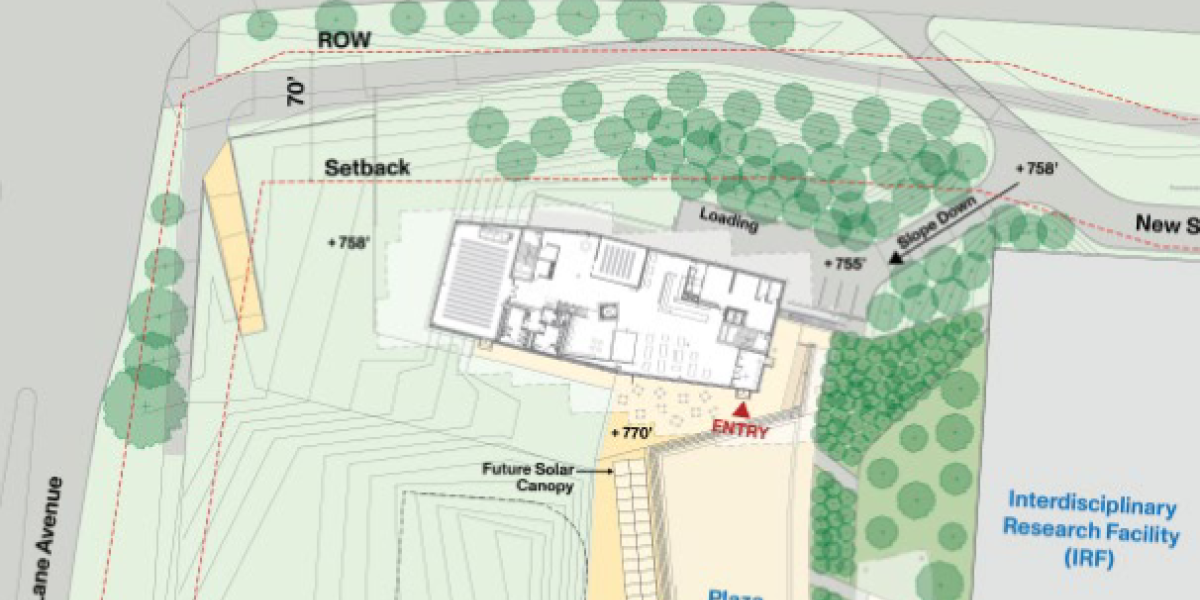The Ohio State University will seek Board of Trustees approval this week for construction of the Energy Advancement and Innovation Center located within the West Campus Innovation District. The building is centered on finding innovative solutions for energy reduction and will allow researchers to develop, demonstrate and deploy innovations in sustainable building design and performance.
“Ohio State is uniquely positioned to bring together researchers from a variety of backgrounds who are committed to a more sustainable future,” said Ohio State President Kristina M. Johnson. “This facility will advance the great work already happening at the university by fostering the type of collaborative, convergent research that is required when facing a complex problem like climate change.”
The Energy Advancement and Innovation Center is a cornerstone of the Innovation District and will be a hub for Ohio State faculty members, students, alumni, ENGIE Buckeye Operations researchers, local entrepreneurs and industry experts to work together on the next generation of smart energy systems, renewable energy and green mobility solutions.
The $36.7 million project is fully funded by Ohio State Energy Partners, which is contributing a total of $50 million. Of the additional funds, $7.5 million will be used as initial seed money for Ohio State ENGIE Labs projects, $4 million in building operating funds and $1.8 million for west campus infrastructure.
“The West Campus Innovation District continues to expand our research capabilities and will attract both world-class researchers and leading-edge companies to work in close proximity,” said Morley O. Stone, Ohio State’s senior vice president for research. “The Energy Advancement and Innovation Center will encourage new diverse collaborations to propel the next generation of convergent energy research and technology incubation.”
In 2017, Ohio State transferred management of the systems that heat, cool and power the Columbus campus to ENGIE to operate these systems on behalf of Ohio State Energy Partners. The Energy Advancement and Innovation Center is a centerpiece of the partnership, which also included a $1.015 billion upfront payment to the university and a $150 million commitment to support academic priorities.
“This project represents the kind of innovation that will fully leverage Ohio State’s academic strengths with ENGIE’s industry expertise,” said Serdar Tufekci, head of major campuses, ENGIE North America. “We are eager to connect the innovation center to the global energy market and bring together technology, services, data and people to tackle some of the world’s toughest energy and sustainability challenges.”
The center’s focus will be developed by an advisory committee chaired by the university and consisting of members from Ohio State faculty and staff, OSEP and the Columbus community.
The 52,600-square-foot Energy Advancement and Innovation Center will be co-located with the Interdisciplinary Research Facility and delivered in conjunction to ensure consistent design and site construction. The project will include the installation of a direct current (DC) microgrid with future plans to install photovoltaics/solar panels on the roof.
“This center will be a marquee place for faculty, staff and students to work side-by-side-side with a global business leader to bring energy innovation to life and help fulfill Ohio State’s ambition to be a leader in developing durable solutions to the pressing challenges of sustainability,” said Kate Bartter, executive director of Ohio State’s Sustainability Institute.
The facility will include a 210-seat seminar room and a 96-seat cafe to serve the Innovation Center and nearby Interdisciplinary Research Facility. Additional building features include:
- Approximately 14,000 square feet of dedicated lab space
- 14,000 square feet for collaborative learning and gathering space
- 1,000 square feet reserved for be smaller focused workspace
- 3,000 square feet shelled for program expansion
Building design began in September 2019 and will continue through March 2021. Pending Board of Trustees approval, the construction would begin in June 2021 with a facility open date of May 2023.
